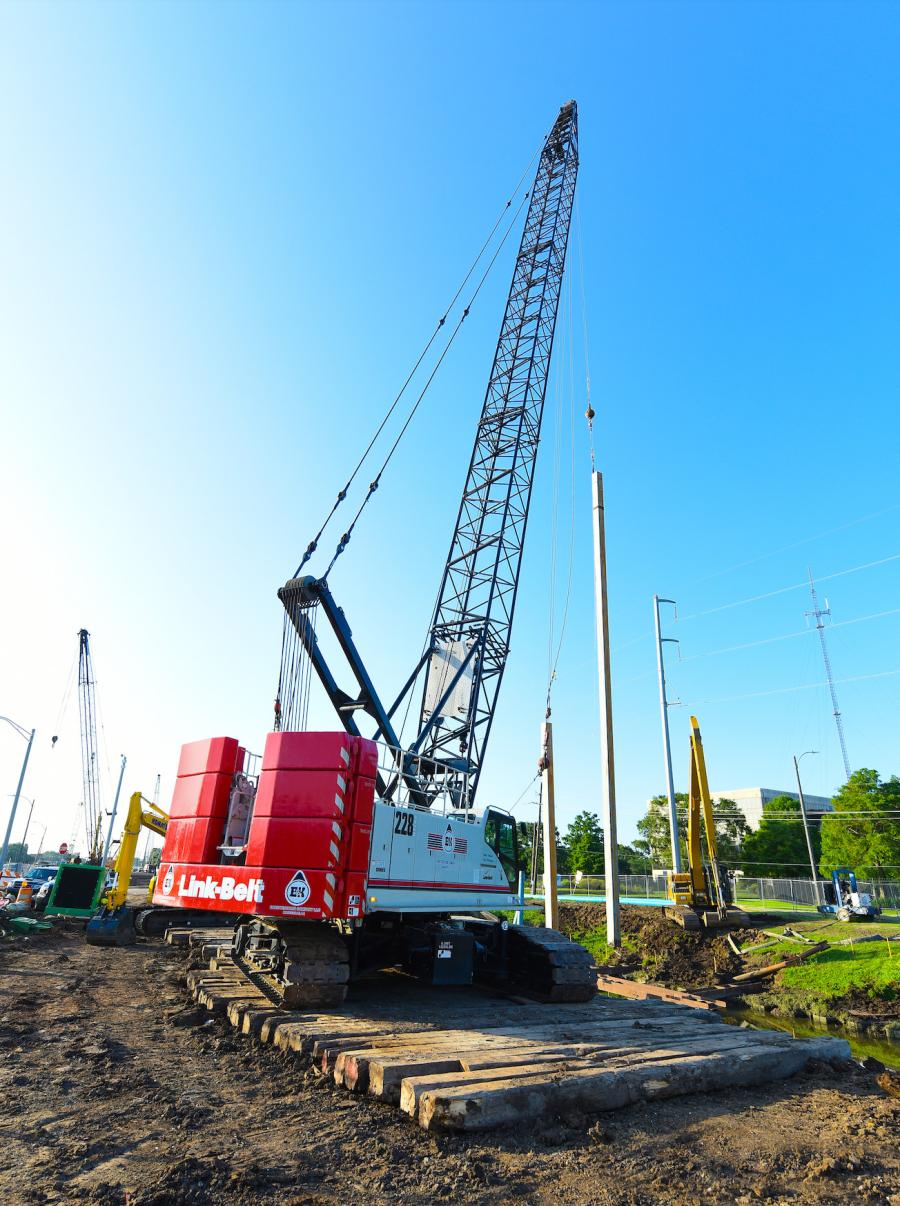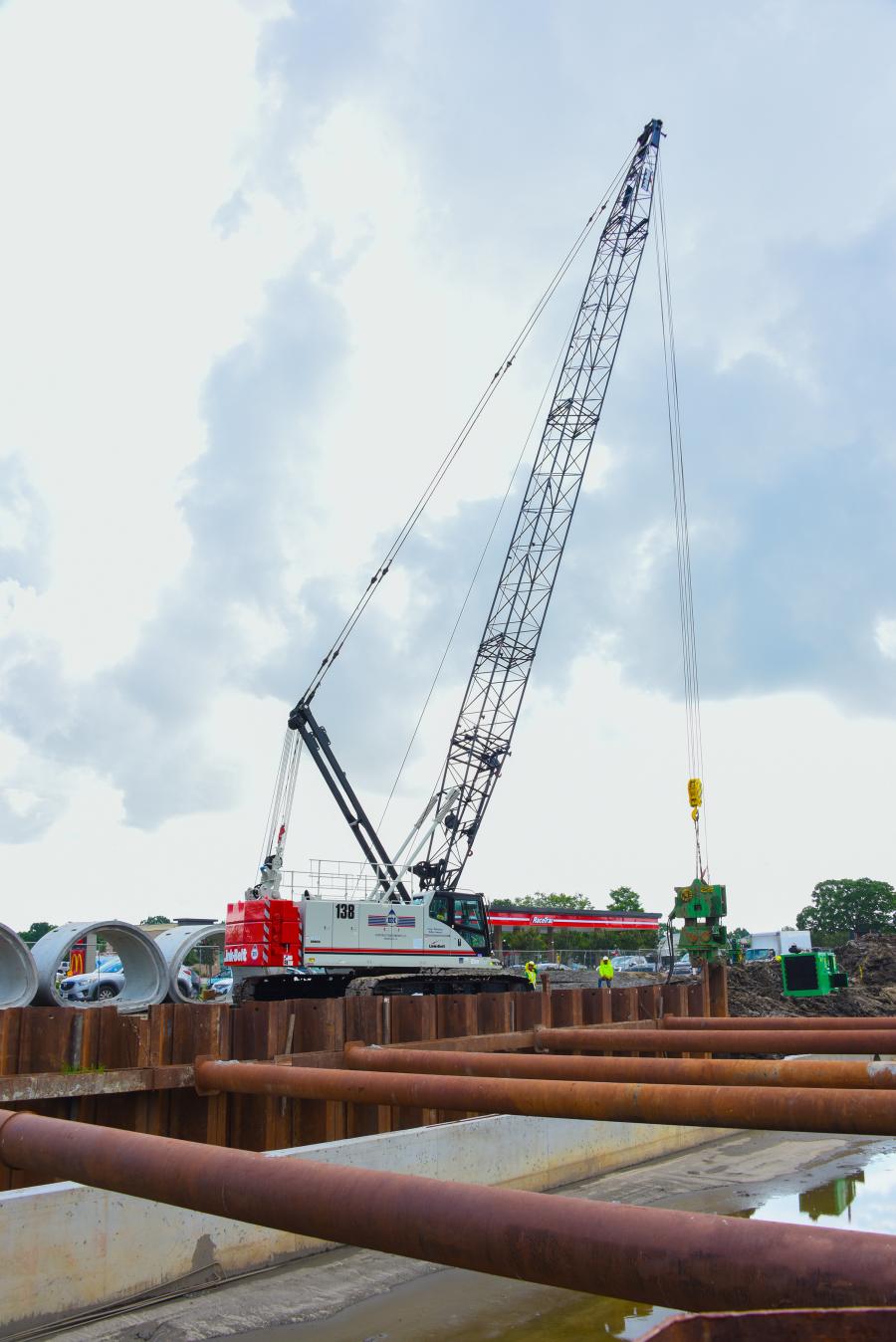Mon May 23, 2022
Link-Belt Cranes
Link-Belt Cranes customer, and long-term contractor for flood control projects in Louisiana, B&K Construction, was awarded a $45.5 million contract for storm channel improvements to the Algiers Sub-Basin Plan.
The project is located on the east bank of the Mississippi River in the Algiers neighborhood of New Orleans and has an estimated completion date of fall 2025. A Link-Belt 130-ton (117.9 t) 228 HSL and 80-ton (73-t) 138 HSL drive the sheeting and piling to build the revamped flood protection network for B&K Construction.
B&K Construction has to first excavate the area to be able to install 70 ft. (21.3 m) tall, sheeting with the 138 HSL. Sheeting lines both sides of the eventual canal walls before reinforcement with whalers and 18 in. (45 cm) steel and 49 ft. (14.9 m) tubular struts. Both cranes sit on timber mats at street level.
"I run a single line, and it's got plenty of power. The two speeds on the winches are great. It is slow or fast and you spin that knob, and it rolls and gets up. The two stage up or down hydraulic on the winch — when you flip it over to the live drop with the break — they handle really well. The swing is smooth and really great," said 228 HSL Operator Mike Comeaux.

Piles are driven into four rows of four piles per section, aided by a 50 ft. (15.2 m) template for placement.
Comeaux works at the far end of the channel with a Vulcan hammer and company built 100-ft. (30.4 m) tall leads that house the hammer at about a 50 ft. (15.2 m) radius. The hammer and leads were about 35,900 lbs. (16,283 kg) rigged while the crane hoisted its load at a 72.4 degree boom angle.
"Sometimes I use the fine tuning for my drums when handling sheeting with the vibratory hammer. Sometimes we have to pick them both up when you are pulling sheet pile, and you have the vibratory on the main line with the whip line on the sheet pile. You want them to come up at the same time, so you can adjust it when you pull the levers so they both come together. One line does not outrun the other one. It's a handy function," he explained.
"Now that I have mastered that throttle, it's really great. When you spin that throttle, you not only increase the flow of the hydraulics, but the speed of the engine comes up, and this big boy moves. He really moves well."

A 228 HSL stands up a section of concrete pile.
Approximately 4,100 ft. (1,249 m) of an original 25 ft. (7.6 m) wide earthen channel will be replaced with a 40 ft. (12.1 m) wide concrete lined canal. The new canal also will be 5 ft. (1.5 m) deeper, enhancing drainage by more than 200 percent.
The 228 HSL drives 66 ft. (20.1 m) long, 14 in. (35 cm) square prestressed concrete piling to establish a foundation for the new canal. The canal floor will be 3 ft. (.9 m) thick, multi-layer concrete. Each side of the canal will be 5 ft. 9 in. (1.75 m) high and 18 in. (45 cm) thick.
There are several benefits to this additional capacity for storm water runoff. It will provide the pump station downstream additional time for pumping water into the Intracoastal Waterway, and alleviate flooding on nearby streets during periods of heavy rain; adjacent General De Gaulle Highway is a hurricane evacuation route.
Piles are driven into four rows of four piles per section, aided by a 50 ft. (15.2 m) template for placement. The template is placed length-wise down the channel, first to support the future outer wall, then two rows of four pile spaced two and a half feet on each side of the centerline to support the floor slab. A fourth row, nearest the crane, will primarily support the nearer outside wall placed one foot off the wall.
For more information, visit linkbelt.com.

A 138 HSL drives sheet pile in the Algiers neighborhood of New Orleans.
 Cranes Equipment
Cranes Equipment Articles
Articles Email Updates
Email Updates Sell Your Machines
Sell Your Machines

 Cranes Equipment
Cranes Equipment Cranes Dealers
Cranes Dealers Cranes Articles
Cranes Articles Email Updates
Email Updates Sell Your Machines
Sell Your Machines